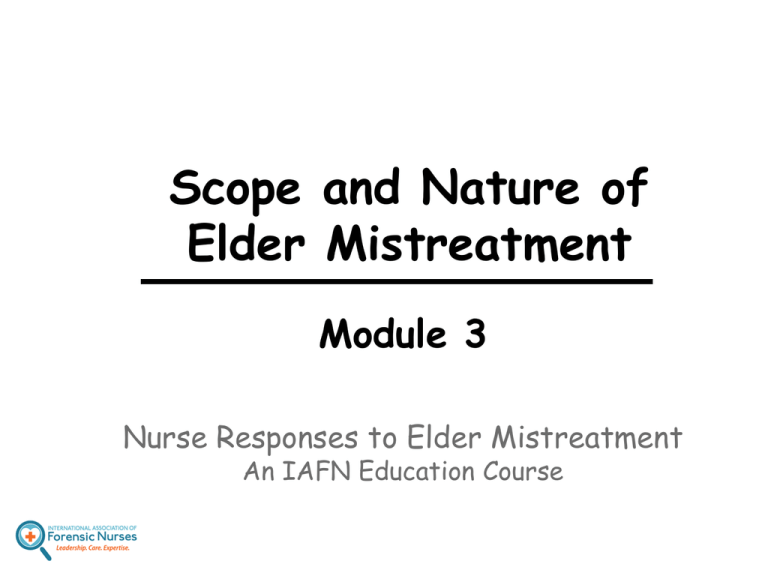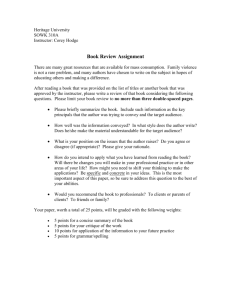
Scope and Nature of
Elder Mistreatment
Module 3
Nurse Responses to Elder Mistreatment
An IAFN Education Course
Case Analysis: Mrs. Kennedy
1.
2.
3.
What are the issues in this case?
What do you currently know to
help you address these issues?
What do you think you still need
to know to respond to these
issues?
2
Elder Mistreatment
Intentional acts by a caregiver or “trusted
other” that cause harm or serious risk of
harm to a vulnerable older adult and/or
omission of acts wherein a caregiver or
trusted other fails to meet basic needs of
a vulnerable older adult
Impairments can increase vulnerability to
mistreatment
Typically not one-time event
3
Types Suspected and Clues
Emotional/psychological abuse?
Neglect?
Physical abuse?
Sexual abuse?
Abandonment?
Financial exploitation?
Violation of personal rights?
4
Clues?
It can sometimes be difficult to
distinguish elder mistreatment (EM)
from problems that occur due to
progression of aging, disease or
chronic conditions and/or medication
changes
5
Module 3 Topics
Incidence, prevalence and risk factors of EM
Signs of possible EM
Common age, disease-, chronic condition- and
medication-related changes that may mimic
possible EM
Family violence in later life, elder
mistreatment in institutional settings and
elder sexual abuse
6
Prevalence and Misconceptions
What misconceptions about extent and
nature of EM have nurses seen held as
truth in their work settings or in their
communities?
How do these misconceptions impact
interactions between patients and health
care providers and subsequent
interventions?
www.coaottawa.ca/elderabuse/documents/10Myths.pdf
7
Prevalence Estimates
1 to 2 million Americans age 65+
2 to 10% of 65+ population
Drawn from National Center on Elder Abuse, Elder Abuse Prevalence and Incidence
http://www.elderabusecenter.org/pdf/publication/FinalStatistics050331.pdf
8
Additional Data…
Rates of reporting
Who are victims?
Who are perpetrators?
Risk factors
o
Caregiver stress?
Intentionality of mistreatment?
9
One Sign Doesn’t Indicate EM
A pattern of physical, behavioral
and environmental signs point to a
need to question whether
mistreatment occurred
National Center on Elder Abuse, Frequently asked questions
Center for Substance Abuse Prevention, Out of the shadows: , Uncovering substance use and elder abuse, 2004
10
Signs of EM
Emotional/psychological abuse
Neglect
Physical abuse
Sexual abuse
Abandonment
Financial exploitation
Violation of personal rights
11
Health Changes and Functional
Effects in Older Adults
Skin
Cardiovascular system
Musculoskeletal system
Neurological System
Sensory System
Gastrointestinal system
Hormonal system
Also, medication effects…
12
Focus on…
Family violence in later life
Institutional elder
mistreatment
Elder sexual abuse
13
Questions to Consider…
For each case, what is alleged perpetrator’s
relationship with victim? Where did EM
occur (community or institution)? What
types of mistreatment do you think
occurred? How does perpetrator use victim’s
vulnerabilities to control or exploit? Is
victim able to reach out for help?
What are challenges that nurses might face
when presented with these different types
of cases?
14
Abuse in Later Life Wheel
National Clearinghouse on Abuse in Later Life, 2006
Based on the Power and Control/Equality wheels developed by the Domestic Violence Intervention Project, Duluth, MN
15
Pattern of Controlling Tactics
Wheel shows pattern of controlling
behaviors that make it very difficult for
victim to leave abusive relationship
Perpetrators often use victims’
vulnerabilities to maintain control
National Clearinghouse on Abuse in Later Life, Interactive training exercises on domestic abuse in later life, 2003
16
Who are the Perpetrators?
Spouse/intimate partner
o
o
o
Domestic violence grown old
New life partnership/marriage in
later life
Late onset abuse
Adult child, grandchild, or other
family member (e.g., sibling)
B. Brandl & D. Horan, Domestic violence in later life:
An overview for health care providers, Women and Health, 2002
17
Health Care Providers
Domestic violence at any age may be
criminal
Assist victims in making their own
decisions
Dangerous to believe abuser accounts
Don’t medicate patients rather than
identify abuse
Make safety/support options available
18
Health Care Providers
Don’t blame victim or collude with
batterer
Don’t minimize potential danger to
patients or health care providers
19
Family Violence in Later Life
Strangulation/suffocation
Homicide-suicide
20
Institutional EM
Research suggests that vulnerable
individuals living in licensed nursing
homes and other residential care
facilities, on any given day, are at much
higher risk for abuse and neglect than
older persons who live at home
C. Hawes, Elder abuse in residential long-term care settings:
What is known and what information is needed?, in R. Bonnie & R. Wallace (Eds.), Elder mistreatment,
abuse, neglect and exploitation in an aging America, 2003
21
One study of 80 residents in 23
nursing homes in Georgia
44 % reported being abused
48 % reported being treated roughly
38 % reported seeing other residents being
abused
44 % reported seeing other residents being
treated roughly
95 % reported they had been neglected or
witnessed other residents being neglected
Atlanta Long-Term Care Ombudsman Program ,
The silenced voice speaks out: A study of abuse and neglect of nursing home residents, 2000
22
Flags: Resident Examples
Signs/symptoms out of proportion to
current problem/resident’s history
Unexplained injuries or injuries from
improbable causes
Behavior changes after resident has
visitors or a particular staff member
is in room (crying, depression, etc.)
L. Phillips, Issues in Identification of Mistreated Elders (Slide presentation)
23
Offenders: Institutional Settings
Staff
Family of residents
Other visitors to facility
24
Underreporting
Health care professionals
Residents and family
Ombudsmen
25
Sexual Abuse
Continuum can include:
o
o
o
o
o
o
-Forcing victim to view pornography or listen to
explicit sexual accounts or comments
-Coerced nudity/sexually explicit photographing
-Sexualized kissing and fondling
-Oral-genital contact/digital penetration
-Vaginal rape/anal rape
-Rape by objects/attacking victim’s genitals with
blows or weapons
o
K. Vierthaler, Addressing Elder Sexual Abuse: Developing a Community Response, 2005
26
Sexual Abuse
How do older persons react
to/cope with sexual abuse?
o
o
Emotionally
Physically
27
Offenders: Elder Sexual Abuse
Vast majority are male
Husband/intimate partner with
domestic violence history
Adult son or grandson
Caregiver in home
Caregiver in facility
28
Underreporting
What are barriers to self-reporting
sexual abuse for older persons, in
addition to those discussed already?
Barrier or healthcare providers to
reporting elder sexual abuse?
29
Closing Assessment
What one important thing did
you learn in this module that
you can apply in your practice
setting?
30
30






